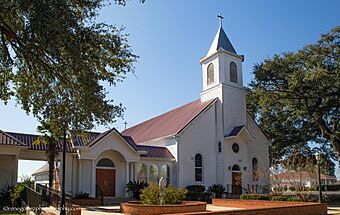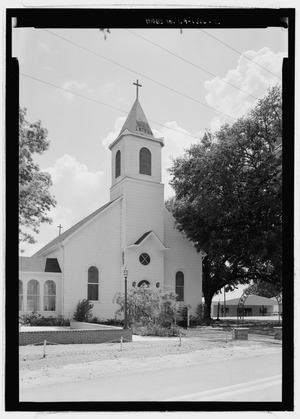St. Augustine Catholic Church and Cemetery (Natchez, Louisiana) facts for kids
Quick facts for kids |
|
|
St. Augustine Catholic Church and Cemetery
|
|

The church in 2019
|
|
| Location | 2262 Louisiana Highway 484, Natchez, Louisiana |
|---|---|
| Built | 1917 |
| NRHP reference No. | 14000679 |
| Added to NRHP | September 24, 2014 |
The St. Augustine Catholic Church and Cemetery, also known as the Isle Brevelle Church, is a very old and important Catholic church property. It was started in 1829 near Melrose, Natchitoches Parish, Louisiana. This church is a special place for the French, Spanish, Native American, and Black Creole community in the Cane River area. It is also the oldest surviving Black Catholic church in the United States.
Louisiana Creole Nicolas Augustin Metoyer helped start St. Augustine as a mission church. It is famous for being the first church in Louisiana built by and for free people of color. It is also one of the oldest churches in the United States started and built by and for African Americans.
The church and its cemetery are part of the Cane River National Heritage Area. They are listed on the National Register of Historic Places, which means they are important historical sites. Because of its special place in Catholic and Creole history, St. Augustine is also a stop on the Louisiana African American Heritage Trail.
Contents
History of St. Augustine Church
How the Church Began (1800s)
People in the area believe that Nicolas Augustin Metoyer founded the church in 1803. They also say that church services have been held there ever since. However, old church records show that the Chapel of St. Augustine officially started as a mission in July 1829. This was shortly after the church building was finished. In 1856, the mission became its own parish and got its own priest.
When Father Jean Baptiste Blanc officially opened the chapel for religious use on July 19, 1829, he wrote about it. He said it was built on Isle Brevelle on Augustin Metoyer's land. Augustin Metoyer and his brother Louis Metoyer helped build it. Louis Metoyer also founded the nearby Melrose Plantation, which is now a very important historical site. The chapel was named after St. Augustine.
St. Augustine Church is unique because of how people sat during services. Records show that the Metoyer family, who were Créole de couleur (people of color), sat in the front seats. Behind them sat important white families and other Creole families from the community. After the Civil War, St. Augustine became even more special. Its members were almost all people of color. But it also served as the main church for a mostly white church called Mission Ste. Anne on Old River.
The very first church building is not here anymore. It is believed that soldiers burned it down in May 1864 during the Red River Campaign.
On March 11, 1856, Bishop Auguste Martin decided that the St. Augustine mission on Isle Brevelle would become its own parish. Father Francois Martin became its first pastor. As its own parish, St. Augustine grew to serve four other churches nearby. These included St. Charles Chapel at Bermuda, St. Anne Church (Spanish Lake) (which served the Adai Caddo Indians of Louisiana), St. Joseph's Catholic Mission at Bayou Derbonne, and St. Anne Chapel at Old River.
The Church in the 1900s
A second church building burned down in the early 1900s. The church building you see today was finished in 1917. People say that the first church had paintings of St. Augustine and St. Louis, honoring the Metoyer brothers. It also had an altar brought from Europe by other family members. The original bell that hung in the bell tower is said to be the same one still used today. There is a painting of the church's founder, Nicolas Augustin Metoyer, that hangs in the church. It shows an image of the original church in the background.
An oil painting called Papa Augustin Metoyer (from around 1836) has been in the church since the 1970s. It shows Nicolas Augustin Metoyer wearing a special coat. This painting used to be at Melrose Plantation. When it was put up for auction in the 1970s, the church's pastor brought the oldest family members of Nicolas Augustin Metoyer to the auction. They asked to buy the painting so it could be displayed in the church for the Isle Brevelle community.
For many years, the Isle Brevelle community has held an annual festival at St. Augustine Church.
The Isle Brevelle Creole Community
The first Creole person to settle in this area was Jean Baptiste Brevelle II. Both Isle Brevelle and Bayou Brevelle are named after him. Brevelle was an explorer and soldier in the 1700s. His father was Jean Baptiste Brevelle, a trader from Paris, and his mother was Anne des Cadeaux, an Adai Caddo Indian woman. Jean Baptiste Brevelle II's baptism was recorded in 1736. This is in the oldest Catholic record book in the Louisiana colony. Brevelle was given the island in 1765 for his work as a translator for the Caddo Indians and for exploring many areas.
The Metoyer brothers, Nicolas Augustin and Louis, were two of ten children. Their father was a French merchant named Claude Thomas Pierre Metoyer. Their mother was Marie Thérèse Coincoin, a former enslaved woman. She was a very successful businesswoman and planter. She worked hard to buy the freedom of her five older children from an earlier time when she was enslaved. She was able to free three of them. Together, her children and their families created a large community of Créole de couleur in Natchitoches Parish. This community spread along the Cane River Lake.
The heart of this community was, and still is, St. Augustine Parish on Isle Brevelle.
St. Augustine in Books and Movies
- Elizabeth Shown Mills wrote a historical novel called Isle of Canes. This book uses family stories and old records to tell about the founding of St. Augustine. It also explores the religious leaders of the Isle Brevelle community.
- The church is shown in the 1982 historical movie Cane River. This movie was lost for many years but was found again and released digitally and in theaters starting in 2020.
See Also
- National Register of Historic Places listings in Natchitoches Parish, Louisiana
- Isle Brevelle
- Cane River
- Bayou Brevelle
- Melrose Plantation
- Anne des Cadeaux
- Natchitoches Parish
Notable People Connected to St. Augustine
- Clementine Hunter (around 1887–1988): A famous self-taught folk artist. She lived at Melrose Plantation on Isle Brevelle and went to mass at St. Augustine.
- Marie Thérèse Coincoin (1742–1816): A planter and businesswoman. Her sons were important people who helped build and support St. Augustine Church.
- Anne des Cadeaux (died 1754): A Native American woman. She was the mother of Jean Baptiste Brevelle II. She is buried on Isle Brevelle. St. Augustine Church is built on land that belonged to her family. Her descendants were also important supporters of St. Augustine.
- Jean Baptiste Brevelle (1698-1754): An early explorer, trader, and soldier at Fort Saint Jean Baptiste des Natchitoches. He was the husband of Anne des Cadeaux and the father of the person Isle Brevelle is named after.
- Robert Brevelle (born 1977): A well-known venture capitalist and tribal councilman of the nearby Adai Caddo Indian Nation. He is a direct descendant of the founder of Isle Brevelle and a supporter of St. Augustine.




